The Collision with Paganism
Conspicuous by their absence at the great Roman civic festivals, early Christians were often viewed with suspicion and mistrust. Woolsey Professor of Biblical Studies Yale UniversityBEYOND PALESTINE
How would this rather unusual claim [of a resurrected Messiah] or message have fallen on the average pagan ear?
That's the most difficult question of all. This is obviously an interpretation which begins within a Jewish framework, which is based upon Jewish scriptures ... which are understood within Jewish institutions and Jewish traditions. Now, the really difficult thing is, to explain that great jump that takes place when Christianity moves out of the villages of Palestine into the urban centers of the Eastern Roman provinces, and very quickly crosses the boundary between the local Jewish community, which doesn't respond terribly well to this message, to those outside, the ordinary members of these multi-cultural Greco-Roman cities, who don't have any concept of Messiah, couldn't be less interested in a King of the Jews, who find the notion of resurrection from the dead a very odd concept, at best. How did they make that transition, how did they transform their message to make sense of it to those people?
IMMIGRANTS IN THE GRECO-ROMAN CITIES
One of the characteristics of the Roman Empire [in] this period from the end of the Republic, right on down to the decline of the Roman Empire, is that there is suddenly great freedom of movement, more so than any period before that and in some ways, more free that any period that will happen again, until the invention of the steamship. This means that in every city in those Eastern Roman provinces there will be a variety of people who have immigrated there from other places, so that you will have many ethnic groups who have had to adapt to a larger culture and they do this in two ways. One by assimilating to a pattern, which has been imposed upon this by things Greek and things Roman - the powers of culture and the powers of politics. And the other way is by trying to maintain their identity by importing things from their homelands, and those things which they import, which establish identity, are more often than not, a religio[n]...
DELOS
For example, if [you]... go to the ancient island of Delos and just look at the archaeological remains of the various immigrant groups, you will see here a place where the Italians have established an association, over there you will find a great clubhouse, which is built by the immigrants from Beirut, who have established there a cult center for their god, whom they now name Neptune and Poseidon, because that's understood in the larger culture. Up on the hills you'll find shrines of the Egyptian gods, and so on. On the back side of the Island, we will find within 100 yards of each other, the location of the Samaritan group and of the Jewish Synagogue.
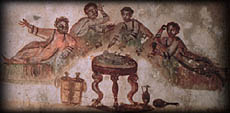 So, how did these people establish themselves with some identify of their own, within this culture? And, the answer, I think, is to be found ultimately in the peculiarities of the Greco-Roman family, the household. Again and again, you will find that a group has come in, they have settled in a certain area, with people from similar homelands and similar beliefs and similar identity. They will have formed an association around their native gods, and they will have found some patron, who may be a member of the group, maybe from outside the group, but someone who has means enough, to provide a place for them to meet - invites them into his home or her home, for often times the patron will be a woman, ... and there provides them a place, some security and a kind of bridge... to the larger society. The Jews have followed the same procedure.
So, how did these people establish themselves with some identify of their own, within this culture? And, the answer, I think, is to be found ultimately in the peculiarities of the Greco-Roman family, the household. Again and again, you will find that a group has come in, they have settled in a certain area, with people from similar homelands and similar beliefs and similar identity. They will have formed an association around their native gods, and they will have found some patron, who may be a member of the group, maybe from outside the group, but someone who has means enough, to provide a place for them to meet - invites them into his home or her home, for often times the patron will be a woman, ... and there provides them a place, some security and a kind of bridge... to the larger society. The Jews have followed the same procedure.
DURA-EUROPAS
Another place that is very helpful to see this [is] a little town on the banks of the Euphrates River, called Dura-Europas, which had the good fortune to be destroyed in the year 256, good fortune, from the point of view of the archaeologists, so that the remains are there, untouched until 1935, when [excavations] started up. And here, we find along one wall of that street, buried under sand, we find a place, which was once a former house, a private residence, that has been made into the shrine of the god Mithras. We find another private home which has been converted into a synagogue, with magnificent paintings on the wall, and we find another small house, which has been converted into a Christian meeting place, with a baptistery, also with paintings on the wall. This rather graphically illustrates this procedure by which the private household, can be become a kind of bridge head for a new group, establishing its identity, enabling it at the same time to fit into the larger society of the city but also to maintain its own customs and its own special identity.
CHRISTIANS -- A NEW FAMILY
How did Christian groups relate to this [phenomenon]?
So, among these immigrant groups... a group who would be Christians shows up,...but there's something strange about this. They're not an immigrant group. They didn't come from anywhere. They begin, doubtless, as an offshoot of the local Jewish community, but they came from all over. Their ethnic composition is varied and yet they behave as if they were immigrants from somewhere. They have all the trappings of an immigrant group, and this is a peculiarity. How did they get to be different enough that they preserve a certain identity, by their practices and by their beliefs, over against the surrounding culture? And I suppose the answer has to be that they are what modern sociologists would call a "conversionist group." [This] means that, if you belong to this group, you don't belong to any other. The process of initiation, which makes one a member of this group, at the same time cuts one off from the other groups that one had belonged to before, even perhaps one's family, and that is the side of it that makes one look like an immigrant. The very language that they use, calling one another brothers and sisters, children of God, and so forth, implies this kind of re-socialization, in which they have become a different kind of family, a different kind of community.
EARLY CHRISTIAN RITUALS
Among the things that make the Christians different are a couple of rituals which they developed, early on before the very earliest sources that we have about them. One of these is an initiation ceremony, which they call baptism, which is simply a Greek word that means dunking. It's interesting that if you go to the little town of Dura-Europas and that 3rd century Christian building... precisely where one would expect to find the statute of one's god in any of the normal shrines of a religious group, you find what we would think of as a bathtub, with some interesting paintings on the wall behind it. This is the Baptistery. This is the place where people are initiated into this new cult. Why is that the center? Why is that the focal point? Clearly something happens here which is fundamental to the establishing of identity of a group, which at the same time binds them together so that they speak of themselves with family terms but also separates them, in some sense, from the society around them.
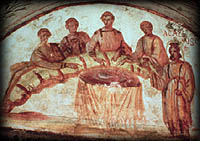 A second major ritual which they developed is a meal, a common meal, which they have together, which is designed as a memorial of The Last Supper which Jesus had with his disciplines. This is recorded already in one of the letters of the Apostle Paul, and he presents this as a tradition which he has received and handed on to the people in Corinth. So, it's a very, very early thing and has various interpretations, but as a ritual, clearly this is an ongoing way in which the community has gathered and reasserts their unity with one another and their difference from others.
A second major ritual which they developed is a meal, a common meal, which they have together, which is designed as a memorial of The Last Supper which Jesus had with his disciplines. This is recorded already in one of the letters of the Apostle Paul, and he presents this as a tradition which he has received and handed on to the people in Corinth. So, it's a very, very early thing and has various interpretations, but as a ritual, clearly this is an ongoing way in which the community has gathered and reasserts their unity with one another and their difference from others.
In the long run, it was Christianity in Rome that kind of emerged at the top of the heap. Why you think that happened?
At least as far as Western Christianity is concerned, Rome finally emerges as the center of things and as the broker of power. In one sense, it's perfectly natural. We're talking about a movement which develops in the Roman Empire, after all, and Rome is the capital.... Obviously, this political center and cultural center carries over into ecclesiastical politics and ecclesiastical culture, as Christianity emerges as a group, more and more at home in the culture of the Roman Empire.
It sounds as if Christianity was able to sort of spread and succeed and survive, partly because it more and more took on - it kind of imitated, in a sense perhaps, some of the practices of the Empire.
The relationship between the Christian groups and the largest society around them, the culture, around them, is ambiguous and ambivalent, from the very beginning. On the one hand, one of the sources [of] their power, is [that] they're different. They behave like a group of immigrants, even though they're not immigrants. They mark themselves off from the culture around them. They're different, they're seen as different, by outsiders and by themselves. On the other hand, they depend upon things which are utterly common in that culture. They interpret themselves with the symbols and the language and the expectations that are common to many, many groups, both religious and otherwise, in that culture. On the one hand, they want to set themselves apart. On the other hand, they want to attract everybody, and this ambivalence, this paradox between the in-group and the culture outside, persists, I think, through all of Christian history....
Professor of Classics and Director of the Religious Studies Program University of Texas at AustinPAGAN VIEW OF CHRISTIANS
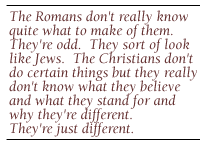 What did the neighbors think about the member of this new cult, these so-called Christians?
What did the neighbors think about the member of this new cult, these so-called Christians?
By the early part of the second century it appears that the Christians, because they're no longer being viewed as a sect of Judaism, are really being considered by their pagan neighbors as another one of these foreign cults that have crept into the Roman world, and clearly in some cases it's causing a great deal of concern and consternation on the part of their neighbors. They don't know quite what to make of them. They don't know quite what they're teaching or what they're saying or what they're doing so some questions begin to come up.
We tend to think of Christianity over against paganism in the Roman empire but we have to be a little bit cautious about what we mean by paganism. First of all paganism itself is really not a religion. There is no such thing as the doctrine of paganism. In fact we have to remember that it's the Christians who use the term pagan to define those people who are not Christians. It's a Christian term for another group or the other people and so really it's a Christian's way of thinking....
How do my neighbors know that I'm a Christian? It sounds terribly personal.
In many respects we probably have to assume that Christians on the whole wouldn't have looked all that different from their neighbors. In many places and at many times they would have fit in very nicely with their larger social environment. They would have just blended in. With a few key exceptions, and this is where the Christians become more noticeable to their pagan neighbors. They don't go to the temples. On important feast days when it would be customary to offer sacrifices on behalf of the health of the emperor and on behalf of the health of the state. The Christians probably would have viewed these ritual performances as incompatible with their belief in the one true God. So Christians would have been on those occasions conspicuous by their absence.
When the Christians really do become much more prominent in the social arena of Greek and Roman cities, the pagans start to take note of their absence from important festival days and they're unwillingness to participate in certain aspects of social life.... [O]nly when there becomes a large enough proportion of Christians in the empire as a whole and in the cities in particular that their neighbors can really start taking notice of them [do] persecutions commence.
ALEXAMENOS WORSHIPS HIS GOD
Could you describe the graffiti of Alexamenos and its significance? What does it suggest about how Christians were seen?
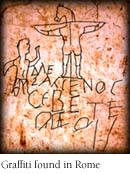 One of the major implications that we get from this material in the early
second century such as the letters of Pliny describing the Christians is that the Christians at this stage are still something new, something novel from the perspective of the Romans. The Romans don't really know quite what to make of them. They're odd. They sort of look like Jews. The Christians don't do certain things but they really don't know what they believe and what they stand for and why they're different. They're just different. They're foreign. [W]e have a good example of this kind of pagan perspective on Christians from a little graffiti found in Rome from the Palatine Hill. It shows a man hanging on a cross and below it is an inscription scratched very crudely into the wall.... It's quite literally graffiti in the modern sense of the term and it says Alexamenos worships his god. In the picture we see Alexamenos bowing down before the man on the cross, but the unusual thing is that the man on the cross has the head of a donkey. From the perspective of these pagans there was this unusual belief attached to Christianity. They're worshipping a crucified man, that in of itself is probably something that they would have thought odd, and secondly the identity of this crucified man is somehow confused with animal deities... some sort of peculiar half animal, half man person. The pagans really don't know quite what to do with all this.
One of the major implications that we get from this material in the early
second century such as the letters of Pliny describing the Christians is that the Christians at this stage are still something new, something novel from the perspective of the Romans. The Romans don't really know quite what to make of them. They're odd. They sort of look like Jews. The Christians don't do certain things but they really don't know what they believe and what they stand for and why they're different. They're just different. They're foreign. [W]e have a good example of this kind of pagan perspective on Christians from a little graffiti found in Rome from the Palatine Hill. It shows a man hanging on a cross and below it is an inscription scratched very crudely into the wall.... It's quite literally graffiti in the modern sense of the term and it says Alexamenos worships his god. In the picture we see Alexamenos bowing down before the man on the cross, but the unusual thing is that the man on the cross has the head of a donkey. From the perspective of these pagans there was this unusual belief attached to Christianity. They're worshipping a crucified man, that in of itself is probably something that they would have thought odd, and secondly the identity of this crucified man is somehow confused with animal deities... some sort of peculiar half animal, half man person. The pagans really don't know quite what to do with all this.
As pagans saw it, was Christianity kind of a stupid religion?
Even if we hear a fair amount of pagan attack on Christianity as stupid or criminal and we do know that some persecutions occur, we shouldn't necessarily assume that all Christians were against the Roman government, were marginal parts of society. In many cases, Christians did participate in social activities and were good citizens. Indeed the Christians often claim, "We are the most ethical part of your empire. We behave better than the rest of you. Why would you want to persecute us?"
CHRISTIAN PARTICIPATION IN PAGAN CULTURE
When we hear of pagans claiming that Christians are kind of antisocial -- "haters of humanity" is the terminology that the pagans themselves would have used -- what they're really referring to is the unwillingness of Christians at various times to participate in some of the most common aspects of the religious life of cities. We have to remember that religion in the ancient world is very much a part of public life. They had no idea of a separation of religion and state. Indeed quite the opposite. Religion was one of the most important features of the maintenance of the state. One offered sacrifices on certain days as a part of the celebration of the founding of the state. One offered sacrifices on the birthday of the emperor. Cities very often mounted these enormous celebrations to celebrate the emperors and all the populace would have been expected to come and join in and for most people you wanted to join in. After all, this would have been a public celebration. A great festival.... Better yet, the aristocracy was paying for it. The city magistrates were the ones who were paying for the food and the celebrations and if you were a common member of the city, you could just go and enjoy yourself. For a lot of the lower classes it's probably the case that this was the only time that they got to eat certain kinds of food. The sacrifices that were offered in the temples were often then distributed as picnic baskets for the people. So on these kinds of festival days to go and participate was one of the important things to do.
It's in this context in all probability that some of the antipathy toward Christianity began to develop, precisely because the Christians wouldn't go and participate. They didn't want to go to the temples and celebrate the birthday of the emperor. They didn't want to take the food that had been sacrificed to the pagan Gods home and eat it at their dinner tables because to do so might have put them in the position of participating in the very idolatry that their religion could not condone.
CHRISTIAN APPROPRIATION OF PAGAN SYMBOLS
 The integration of Christian intellectual and religious life into the Roman world can be seen in a number of different ways: their participation in social life, their participation increasingly in public activities, but it can also be seen in some of the smaller and more intimate symbols of Christian identity that one begins to find in the Roman world. Two of the most important artistic symbols that we find are the good shepherd and the orans or the standing figure in the position of prayer that we see so prominently in the catacombs. ...[W]hat is very important to recognize is that both of these symbols are actually old pagan symbols that had been around in the Roman world for quite some time, and in fact even within the catacombs it's very difficult to tell sometimes when one of these paintings is Christian or pagan, so that while we have this figure of the shepherd with the sheep draped over his shoulders or standing dutifully at his feet, we now may tend to think of that as reflecting the gospel stories of Jesus of the lost sheep or Jesus as the good shepherd from the Gospel of John. In point of fact, from Roman perspective, this is the virtue of philanthropy, of love of humanity, and it's one of the most important virtues of Roman civic and public life. The Christians seem to take it over very readily and apply it to the gospel virtues as well. In the case of the orans figure..., this is the old pagan virtue of piety, of loyalty to the state, and so the person standing with eyes up cast toward heaven and hands in a gesture of appeal to the gods could have been seen by a pagan as a sign of loyalty to the state, loyalty to the old gods. To the Christians it becomes loyalty to the God of Jesus Christ.
The integration of Christian intellectual and religious life into the Roman world can be seen in a number of different ways: their participation in social life, their participation increasingly in public activities, but it can also be seen in some of the smaller and more intimate symbols of Christian identity that one begins to find in the Roman world. Two of the most important artistic symbols that we find are the good shepherd and the orans or the standing figure in the position of prayer that we see so prominently in the catacombs. ...[W]hat is very important to recognize is that both of these symbols are actually old pagan symbols that had been around in the Roman world for quite some time, and in fact even within the catacombs it's very difficult to tell sometimes when one of these paintings is Christian or pagan, so that while we have this figure of the shepherd with the sheep draped over his shoulders or standing dutifully at his feet, we now may tend to think of that as reflecting the gospel stories of Jesus of the lost sheep or Jesus as the good shepherd from the Gospel of John. In point of fact, from Roman perspective, this is the virtue of philanthropy, of love of humanity, and it's one of the most important virtues of Roman civic and public life. The Christians seem to take it over very readily and apply it to the gospel virtues as well. In the case of the orans figure..., this is the old pagan virtue of piety, of loyalty to the state, and so the person standing with eyes up cast toward heaven and hands in a gesture of appeal to the gods could have been seen by a pagan as a sign of loyalty to the state, loyalty to the old gods. To the Christians it becomes loyalty to the God of Jesus Christ.
PAGANS' RESPONSE TO PAUL
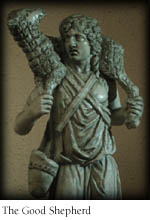 Who was Paul?
Who was Paul?
Paul, who apparently started his life as Saul, was a Jew from the Diaspora, from Tarsus, who according to his own account in his Epistle to the Philippians was a Pharisee, by training. And someone who tried to abide by the Torah, the way of life of the scriptures. Paul had an encounter with the resurrected Christ, which is something reported in the Book of Acts as the Damascus Road experience. That's a dramatization clearly, but Paul himself in his Epistle to the Galatians talks about a revelation of Christ that he had. And through that revelation he became convinced that the person who had died on the cross as a political criminal was, in fact, God's anointed Messiah. And the essence of his gospel, what he preached through the Mediterranean world, revolved around the significance of those two events, the death and resurrection of Christ....
Paul's famous for taking his message to the gentile world out to the Diaspora and then beyond the Diaspora, so how would his message have struck Hellenized Jews and Greeks themselves?
There's one simple phrase in Paul's letter to the Corinthians that summarizes it, that what he was preaching was folly to the Greeks. And there's an episode in the Book of Acts that exemplifies that folly, when on the hill of the Areopagus in Athens, Paul preaches to the philosophers assembled there and tells them about the death and resurrection of Christ. They're all ears until he comes to resurrection, and then they dismiss him as making a claim that's quite preposterous. They would have understood claims about the immortality of the soul, but the notion that the dead body could be resurrected was viewed as ridiculous.
